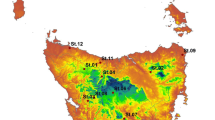Summary
-
1.
Records were obtained with a thermograph over a period of five years in a small stream.
-
2.
Temperature fluctuated from 0°C to above 6°C in January and February; rose during the period from just before the equinox to just after the equinox with daily fluctuations up to about 6°C; remained steadily. Large daily fluctuations were rare in the second half of the year. The highest temperatures was 19.0°C.
-
3.
The highest temperatures were reached when the sun shone strongly after rain, not in dry spells when the water level was low.
-
4.
Temperature fell in a man-made underground channel. In another stream it dropped from 21.6°C out in the open to 14.0°C in a wood facing east on a hot day when the wind was blowing from the east.
-
5.
Temperature reached a minimum at about 6 a.m. and a maximum nearly 12 hours later.
-
6.
Temperatures lower down the stream, fluctuated more; the difference between the maxima was greater than that between the minima.
-
7.
From the present and from published observations it is concluded that small streams warm rapidly and reach equilibrium a few km from the source, the average water temperature being not greatly different from the average air temperature.
-
8.
A given number of degree hours is reached in spring three to four weeks earlier after a warm winter than after a cold one.
-
9.
Average weekly temperature obtained with a thermograph and with a maximum and minimum thermometer read once a day do not differ greatly. Even a weekly reading of the latter gives a fair picture over a long period.
Zusammenfassung
-
1.
In einem kleinem Bach wurde der Temperaturgang fünf Jahre lang mit einem Thermographen gemessen.
-
2.
Die Temperatur schwankte im Januar und Februar zwischen 0°C und ca. 6°C; von Mitte März bis Ende Juni stieg sie, mit täglichen Schwankungen bis zu 6°C;im Juli und August blieb sie hoch und danach fiel sie allmählich ab. In der zweiten Jahreshälfte waren grosse tägliche Schwankungen selten. Die höchste Temperatur war 19°C.
-
3.
Das Wasser war nicht am wärmsten in Perioden ihne Niederschlag und mit niedrigen Wasserstand, sondern bei Sonnenschein nach Regen.
-
4.
Die Temperatur erniedrigte sich deutlich bei Durchgang des Baches durch einen geschlossenen Kanal. Die Temperature eines anderen Baches fiel an einem heissen Tag bei Ost-wind von 21.6°C in einer der Sonnestrahlung ausgesetzten Strecke auf 14.0°C in einer Strecke die an einem ostexponierten Hang durch einen Wald führt.
-
5.
Die Temperatur erreichte ihr Minimum um sechs Uhr früh, ihr Maximum ungefähr zwölf Stunden später.
-
6.
Strömabwärts waen täglichen Schwankungen grösser, wobei der Unterschied in den Maximalwerten grösser war als in den Minimalwerten.
-
7.
Aud diesen Beobachtungen und denen anderer Autoren wird geschlossen, dass kleine Bäche sich rasch erwärmen und unterhalb der Quelle den Gleichgewichtszustand, bei dem sich der Mittelwert dem der Lufttemperatur nähert, erreichen.
-
8.
Im Frühling wird eine bestimmte Wärmessumme nach einem kalten Winter drei bis vier Wochen später erreicht als nach einem warmen.
-
9.
Die mit einem Thermographen oder mit einem täglich abgelesenen Maximum- Minimum thermometer gewonnene durchschnittliche Wochentemperatur ist ungefähr gleich. Wenn die Beobachtungsperiode nicht zu kurz ist, genügt auch eine Messung pro Woche.
Similar content being viewed by others
References
Blunck, H., - 1924 - Die Entwicklung des Dytiscus marginalis L. vom Ei bis zur Imago. 2 Teil. Die Metamorphose (B. Das Larven und das Puppenleben). Z. wiss. Zool. 121: 171–391.
Eckel, O., - 1953 - Zur Thermik der Fliessgewässer: Über die Änderung der Wassertemperatur entlang des Flusslaufs.Wett. u. Leben. Sonderheft 2,41–47.
Eckel, O. & Reuter, H., - 1950 - Zur Berechnung des sommerlichen Wärmeumsatzes in Flussläufen. Geogr. Ann. Stockh. 32: 188–209.
Fry, F. E. J., Hart, J. S. & Walker, K. F., - 1946 - Lethal temperature relations for a sample of young speckled trout, Salvelinus fontinalis. Publ. Ont. Fish. Res. Lab., 66: 1–35.
Fry, F. E. J. & Watt, K. E. F., - 1957 - Yields of year classes of the small-mouth bass hatched in the decade of 1940 in Manitoulin inland waters. Trans. Amer. Fish. Soc. 85: 135–143.
Gorham, E., - 1958 - The physical limnology of northern Britain: an epitome of The Bathymetrical Survey of the Scottish Freshwater Lochs, 1897–1909. Limnology and Oceanography, 3: 40–50.
Ide, F. P., - 1935 - The effect of temperature on the distribution of the mayfly fauna of a stream. Publ. Ont. Fish. Res. Lab. 50: 1–76.
Ricker, W. E., - 1934 - An ecological classification of certain Ontario streams. Publ. Ont. Fish Res. Lab. 49: 1–114.
Schmitz, W., - 1954 - Grundlagen der Untersuchung der Temperaturverhältnisse in den Fliessgewässern. Ber. Limnol. Flussstation, Freudenthal, 6: 29–50.
Sprules, W. M., - 1947 - An ecological investigation of stream insects in Algonquin Park, Ontario. Publ. Ont. Fish. Res. Lab. 56: 1–81.
Author information
Authors and Affiliations
Rights and permissions
About this article
Cite this article
Macan, T.T. The temperature of a small stony stream. Hydrobiologia 12, 89–106 (1958). https://doi.org/10.1007/BF00034143
Issue Date:
DOI: https://doi.org/10.1007/BF00034143




